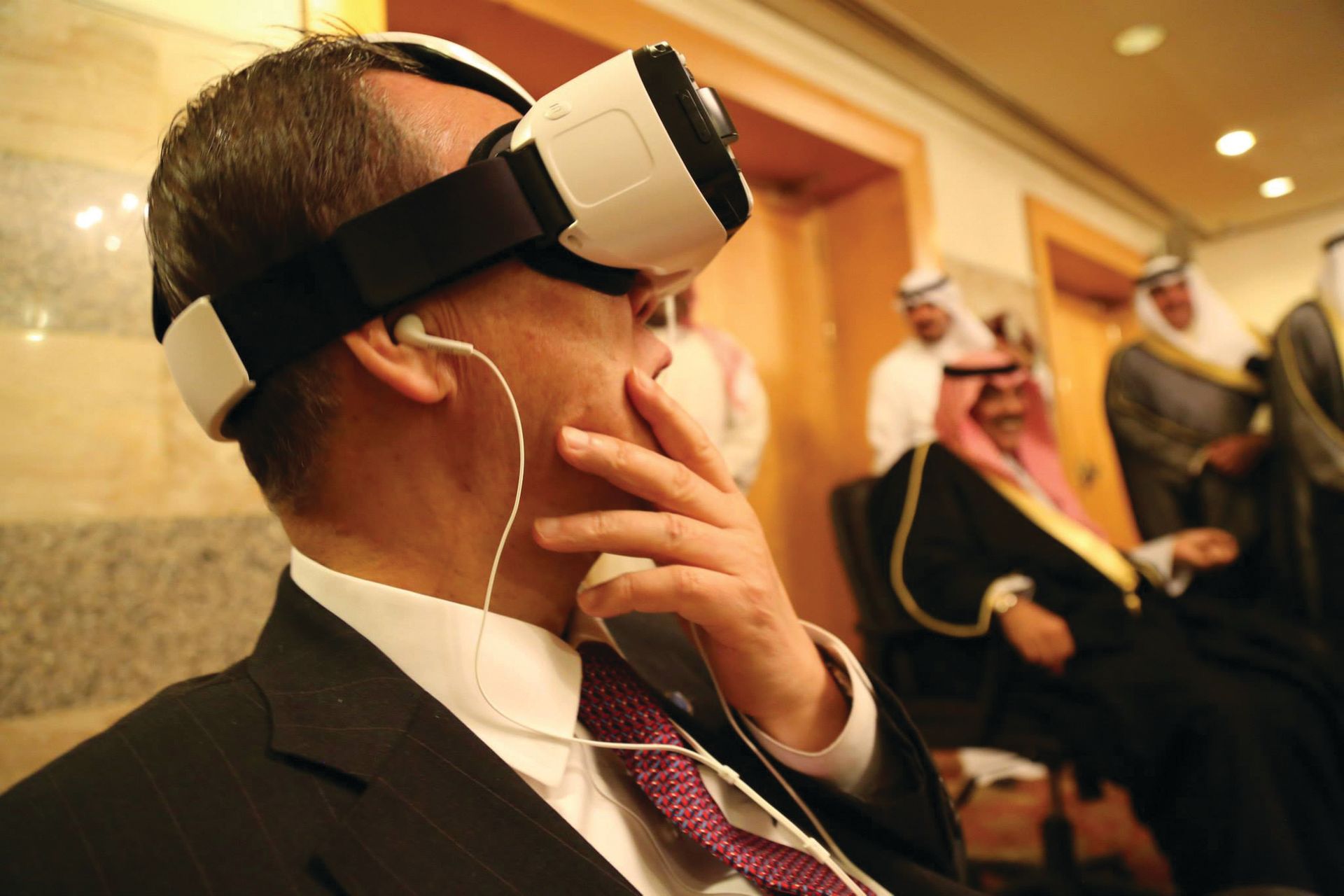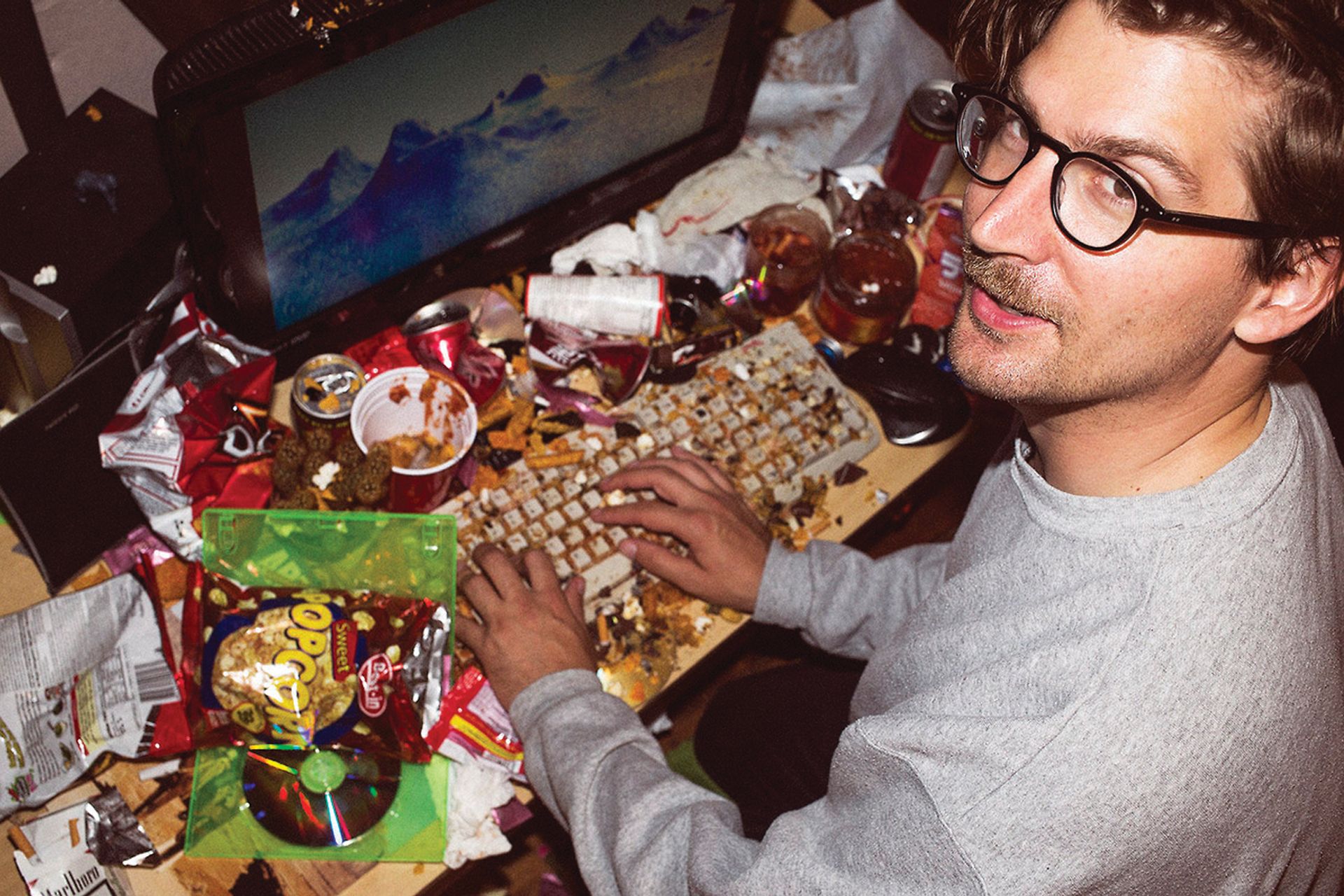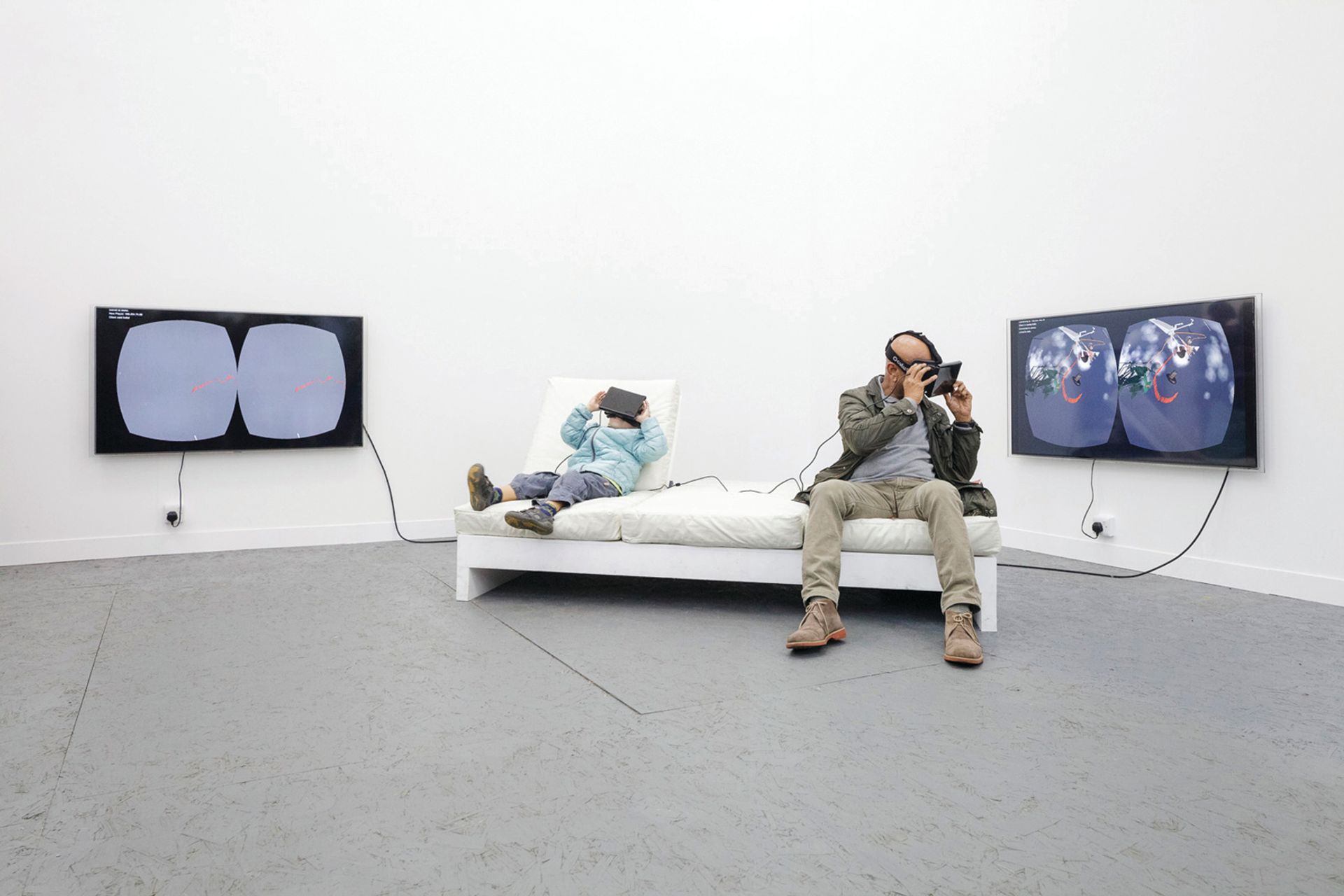At the Zabludowicz Collection in London last autumn, the Canadian artist Jon Rafman created Sculpture Garden (Hedge Maze) (2015), an artificial labyrinth dotted with strange primal sculptures. At its centre was the Oculus Rift, the headset attracting giddy anticipation ahead of it hitting the general market later this year. It is easy to understand why. Putting it on, you were swept upwards into a the canopy of trees surrounding an immersive, imaginary sculpture park; as you glided upwards, you genuinely felt weightless. Virtual reality (VR) has become very real—and artists are using it to powerful effect.
Rafman says that “as a kid I assumed it would become part of our daily reality a lot sooner”. He has explored various virtual spaces in his art, from Google Street View to video games and Second Life, the virtual world created by Linden Lab in 2003. “I have always been interested in immersive worlds,” he says. “I knew that I wanted to do a VR project at the moment that it became feasible to.”
Many artists and designers across numerous creative platforms clearly share his enthusiasm and there is a palpable sense that this year is a breakthrough moment. As Carl Goodman, the director of the Museum of the Moving Image in New York, said when announcing VR360, a programme of VR-related events and exhibitions at the museum this year: “Virtual reality has been ‘just around the corner’ for 25 years. Now we’ve turned that corner and 2016 will be the year when VR transitions from a set of technologies to a true moving image medium.” Lauren Cornell, the curator and associate director of technology initiatives at the New Museum in New York, which will commission three artists to make works using VR this year, as well as hosting a conference on 5 March, also senses a shift. “It has always been imagined, and now it’s finally possible to realise it, so it is something that’s exciting artists,” she says. “I think 2016 is going to be a big year of people testing it out and experimenting with it.”
Enter the metaverse Although VR works have existed in various forms for years, the availability in 2013 of the Rift and its development kit, made by Oculus VR (now owned by Facebook), prompted a major shift. “Those development kits were made very widely available to film-makers, artists and people working broadly in the creative industries,” says Conrad Bodman, who curates digital programmes at the British Film Institute (BFI). “Having access to that particular toolset for creative people has been important.”
Other companies are also in on the act. Google has created Google Cardboard, a low-cost viewer that is indeed made of cardboard, into which you place your smartphone, with various compatible VR apps. The Samsung Gear VR headset also works by using a slotted-in smartphone. Meanwhile, Sony is developing the PlayStation VR headset and HTC will unveil the Vive, both later this year.

As yet, though, little has been experienced beyond the tech industry, and there are cautious voices among curators. “A lot of the hype is coming from the drive towards the release of VR to a consumer market but everyone in the industry is nervous about overselling it; they don’t want another Second Life failure on their hands,” says Ben Vickers, the curator of digital at the Serpentine Galleries in London’s Kensington Gardens. He cites the opening of a virtual Swedish Embassy in Second Life, which is “now going down as an embarrassment in history”.
A key factor in early VR works has been the enhanced emotional quality in the immersive world. Chris Milk, the film director, who is one of the leading exponents of the new technology and founded the VR production company Vrse, has spoken of wanting to make his VR films “empathy machines”. His film Clouds over Sidra, made with Gabo Arora, is perhaps the archetypal film of this kind. Commissioned by the United Nations, it focuses on the daily life of Sidra, a 12-year-old Syrian refugee in Jordan’s Za’atari refugee camp. “That whole sense of the eyewitness that VR can bring is quite visceral,” Bodman says. “You can see it working very well for charities who want to make people aware of global issues and crises.”

Milk is one of a number of artists using VR that straddles numerous cultural disciplines. His work has been shown at Tate Modern yet he is just as likely to make music videos for bands like Arcade Fire. The London-based collective Marshmallow Laser Feast have a similarly cross-cultural practice; their work has appeared in both advertising and in fine art spaces like Bloomberg Space in London. Their work In the Eyes of the Animal was created for Grizedale Forest in the UK’s Lake District in 2015. “It was a really interesting experiment in designing context for VR,” Bodman says.
Julia Kaganskiy is the director of New Inc, the New Museum’s self-styled “incubator” for new ideas, a “shared workspace paired with professional development classes, workshops and mentorships”, as she describes it, which has a VR artist in residence, Rachel Rossin. This interdisciplinary nature of VR work is “a continuation of a trend”, she says. “New Inc itself is full of hybrid practitioners. These are folks who might be artists but they’re also coders, or they’re architects but they’re also really interested in music and they’re thinking about spatial sound. This fluidity between traditional disciplines and traditional fields is producing really exciting new forms, and VR is a space that exemplifies that, but also demands it.”
“Idiots with headsets” It is also testing museum curators in terms of the physical experience within galleries. For its show Sensory Stories in 2015, the Museum of the Moving Image showed four Oculus Rift-based VR works, including Clouds over Sidra. “We learned a lot about what it means to display an inherently solitary type of technology… in a public space,” Goodman recalls. With the headset on, “your existence in the museum becomes a kind of negative space because your body has gone elsewhere,” he says. “You’re an idiot with a headset.”
Daniel Steegmann Mangrané’s work for Surround Audience, the New Museum’s 2015 triennial, explored the disembodied nature of people’s movements when using VR headsets. “He made the use of it performative, because it was hanging from a dog leash and you were wearing it and walking around in this room,” recalls Cornell, who co-curated the show with the artist Ryan Trecartin. “What [other visitors] saw, he wanted it to be a performance, as somebody alone in a white room, walking, and contrast this stark, white, cold, sadomasochistic environment with this immersive world [on the headset].”
“The VR industry really needs artists and wide-ranging creative engagement to make the technology fly
The way that Steegmann Mangrané dealt with the VR component was also provocative. A Spaniard but based in Rio, he recreated an area of a fragile endangered forest outside the Brazilian city in black-and-white VR. “People came to the museum and they wanted a Grand Theft Auto experience, a hyperreal video game,” Cornell explains. “Instead it was something very Minimal, like experimental film-makers would do with film, in a way, in the 1970s. But it was interesting to see people for whom it was their first time wearing an Oculus Rift headset and they were disappointed that they weren’t immediately transported.”
Steegmann Mangrané’s approach is characteristic of artists’ responses in these early stages of VR. “What artists are bringing to it is something different,” Cornell says, “something maybe more experimental than what commercial companies are doing.” The forthcoming conference at the New Museum, co-organised by Kaganskiy, attempts to enrich the conversation around VR and challenge what she describes as the “very self-congratulatory conversation that really champions the medium and the technology”. The conference will, she says, focus on “VR’s past, present and future”, with contributions from everyone from artists and theorists to game developers. It intends “to talk about some of the more ‘existential’ questions of VR”, she says, and seeks “to tease apart what’s happening in this space from a position that isn’t so much privileging what can it do, but what are we doing with it?”

At the Serpentine, Ben Vickers feels that “the VR industry really needs artists and wide-ranging creative engagement to make the technology fly. Immersion and the suspension of reality are absolutely key, and without the involvement of those that understand spatial environments and form, the technology is going to struggle immensely.”
Vickers has collaborated in the past with the British artist Ed Fornieles, who is beginning to experiment with VR. Fornieles’s work is both a celebration and a savage satire of the online world; he has created a Facebook sitcom in the past. “It feels like the tech needs to be broken to become something new—which is maybe what artists are good at,” Fornieles says. “Right now, it feels like it’s being forced into these very known, pre-existing moulds.”
The collapsing balcony Jon Rafman is one artist who is pushing the VR experience into new territory, particularly by locating his projects in related sculptural or real-world environments. During Art Basel in Miami Beach in 2014, he invited visitors to his hotel room, where they found a body on the bed, before walking onto the balcony, where Rafman was waiting with an Oculus headset. He asked them to put their hands to the window pane and look into the room. Putting on the goggles, they saw a virtual reconstruction of it. Then, there was a huge shock. “All of a sudden the entire balcony falls apart,” Rafman says. “A lot of people instantly got this sense of vertigo, because your mind and your touch are convincing you that what it’s seeing and feeling are actually there. And when the balcony collapses, some people thought they were going to fall to their death. I like playing on that gap between the virtual and the real.”
Rafman is keen to point out that he has worked with developers on his VR projects. Conrad Bodman at the BFI suggests that this need to work with experts could inhibit artists’ ability in the medium. “You need to learn quite a lot about the technology to make really powerful work within it,” he says, arguing that there is “a whole new language to making work with VR which artists that have had a more traditional, studio-based practice aren’t familiar with.”

But Ian Cheng, whose work using VR, Entropy Wrangler Cloud (2013), was shown at Frieze London in 2013, suggests that it is important that artists explore the technology themselves. “In my own work, I always want to understand, play, tinker with the technology before engaging with engineers who are better versed with it,” he writes in an email. “I wouldn’t be able to imagine what to do with it if I didn’t. Also, being familiar with a technology is protection against technicians telling the artist ‘No, it can’t be done’, which is a worse lim it than any skill gap. It is early days for VR, and beyond a skill gap there is also a culture gap—there is barely a culture around VR (besides a hype culture), it is not yet part of our everyday reality. So for an artist to engage with VR at this stage, it can only really be about curiosity and play. Other artists engaged in more critical or reactive practices will probably feel disinterested and alienated by VR.”
“It feels like the tech needs to be broken to become something else—which is what artists are good at”
Despite the concerns about hype, there is genuine excitement among artists. “I think this is a great moment in VR,” Jon Rafman says. “It’s a new language, so it is like the early days of cinema where you had people like D.W. Griffith creating the actual language of the medium. In video games or in Hollywood cinema, to create a film or a video game you need hundreds of millions of dollars and it’s controlled by a very few distribution companies, but with VR it is like the Wild West still.”
Negotiating this “Wild West” moment is inevitably difficult for museums. Carl Goodman says the Museum of the Moving Image is “sceptical, in a loving way, of all of this excitement” and is “looking forward to when VR is no longer a curiosity that you have to go to a museum to see, but is something that you can experience at your friend’s house or on your own. Then we can focus less on events that introduce the technology to people and more on curated programmes that feature the best, the most unusual or most challenging work, just as we do with film and have done with film for many years.”
That moment may be some way off, but the era of virtual reality in museums and galleries is well and truly under way.
• VR360, Museum of the Moving Image, New York; Versions: Conference on Virtual Reality, New Museum, New York, 5 March; Chris Milk/Vrse; Marshmallow Laser Feast; Daniel Steegmann Mangrané; Ed Fornieles; Jon Rafman; Ian Cheng

